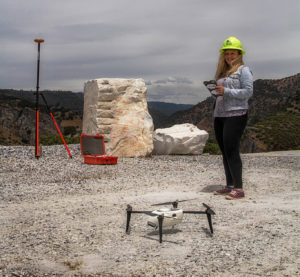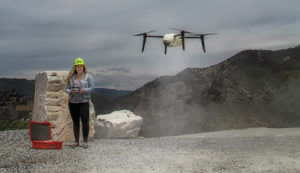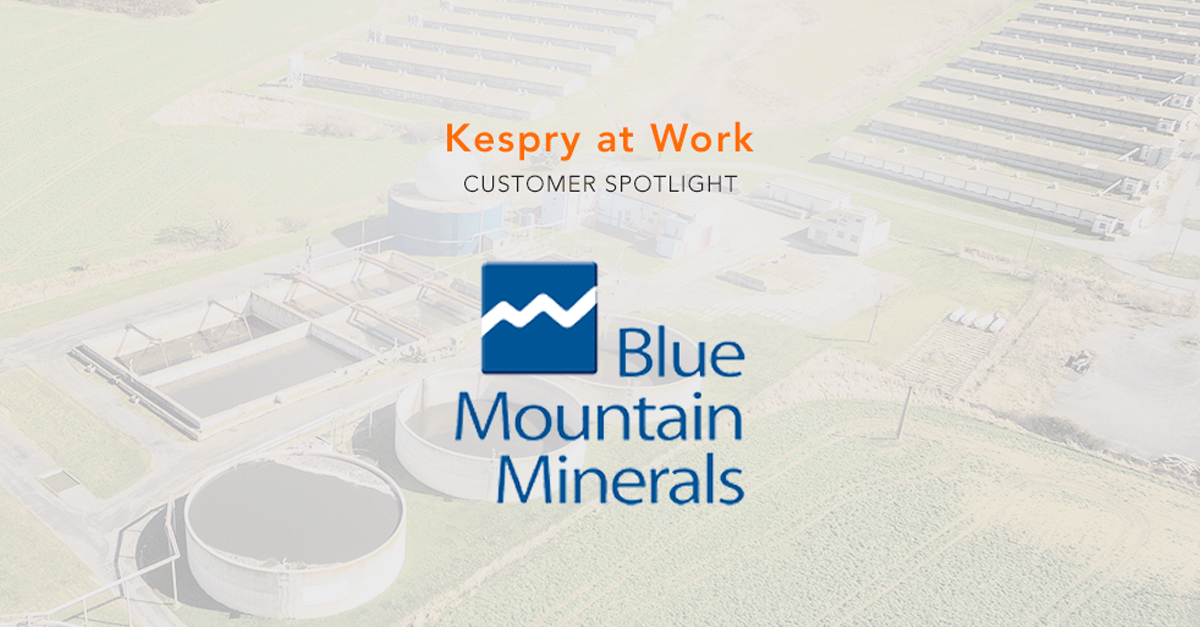Blue Mountain Minerals serves customers in a variety of industrial applications, including building and construction, agriculture, and energy and environment. The company focuses on high-quality limestone and dolomitic limestone across its operations in Northern and Central California. Its limestone output is used for numerous calcium carbonate and calcium-magnesium carbonate products for industrial mineral use in California and throughout the Western United States. Blue Mountain Minerals also has the largest storage capacity in the region with over 11,000 tons of finished product storage available in silos.
We spoke with Vice-President of Operations Steve Brooks, and Geologist and Quality Control Technician Lauren Banish, about the benefits of using the Kespry aerial intelligence platform and how it has changed their business for the better.
Describe the problems you were trying to solve when you first considered acquiring a Kespry system.
Lauren: What really stuck out to me was the ability to use drones to survey blast holes, because the way we were doing it took a lot of time. I was looking for a quicker way to do that. I saw Kespry in a magazine and thought, “Oh, you can use drones for that?” So, the blast hole thing was really the catalyst for even looking into drones. And then we learned all the other applications we could use with it as well.
Steve: The ability to look at pile surveys was also very intriguing to me. The idea that we could know what is in our piles relatively quickly, without having to put boots on the ground or hire a surveyor was really interesting.
Lauren: Only surveying our inventory once a year was a problem, because we have some piles that are really important that we need to keep track of.
Steve: We had major issues with variability of those older surveys as well. Explaining the variability to the accountants was always a challenge. At previous companies, variability was a huge issue, and I had experienced immense write-offs as a result. We want to make sure we’re actually producing what we say we’re producing and that we have the material we think we have in those piles. So, that was a big issue—to verify our other scales, so we were accounting for every ton.

Geologist Lauren Banish prepares to launch a Kespry mission
What previous method did you use for surveying and inventory management?
Lauren: We used a Topcon total station. It took forever—15 to 20 minutes just to set it up. You had to shoot the prisms that were scattered throughout our land, and those are sometimes hard to find, especially in the spring when everything is growing. Kespry is really easy to level compared to Topcon. And I don’t have to drive up to the very top of the quarry of our pit and then try and get the blast holes from an angle. We’re digging deeper and I can’t see the very bottom of the pit with Topcon. It’s a lot easier now that I can just let the drone fly and see them from above. Kespry is a lot quicker. It takes about half the time to get things done as Topcon.
What made you specifically choose Kespry?
Lauren: The big factor is you guys do all the maintenance and everything on the drone itself. That was a big thing. If we bought a drone from someone else and it somehow malfunctioned or broke, we’d have to send it back for warranty service or try and fix it ourselves. We definitely didn’t feel like having to figure that out and deal with it. Another main point is with Kespry, we just set the drone up right outside the office, and it just goes. No special equipment needed.
Steve: We also liked Kespry’s pricing. Everyone else’s pricing was per flight. Kespry’s costs were something we could lock in and know what exactly what they were going to be. When you purchase the Kespry package, you’re purchasing the whole package and we’ve been very impressed with that package and the additions that you’ve added on, including the Kespry Cloud. We’re very happy with our Kespry system.
Lauren: Your processing time is also much faster than other options. We can get topos done and have results within an hour as opposed to 24 hours later with some other systems. The Kespry Cloud aspect is another factor we liked.
Tell us about the process of getting your Kespry system up and running.
Lauren: It was very easy. We had one call to discuss the system in advance of the first flight and we were good to go. We would email Kespry every once in a while for little questions and that was it.
Steve: Kespry also helped us with training and getting us comfortable to take the FAA Part 107 drone operator test.
Lauren: Another thing you guys did really well on was telling us how get all our registrations and licenses taken care of.
Give us some insight into the typical use cases for Kespry at your company.
Lauren: We fly Kespry at least weekly for blast holes. We fly before they actually blast the pattern, and then from there I go and use drop points to get the latitude and longitude of them. The other big thing we do now is we fly at the beginning and end of every month at both of our sites to look at our inventory piles. Recently, we also used Kespry as part of a project to put up solar panels. We used the drone to capture the area and ensure we have the acreage we need available.
Describe how Kespry enhanced your operations.
Lauren: We’ve really been able to watch our production and see, especially down in our southern mine, that we’re doing what we should be doing and that we’re making the tonnage we should be making. So, inventory management really has become the most valuable aspect of it.
Steve: If you can’t measure it, you can’t manage it. And Kespry gives us the ability to measure much more efficiently than before.

How Kespry impacted how you do mine planning, including stripping, overburden, and blasting?
Lauren: Kespry has really been able to give me ongoing, updated frequent topography. With our previous methods, I’d get the big topography at the beginning of the year. That meant I had to manually move the topography to account for wherever the blasts happened to be. Now, I can get topography after every blast. I can actually see how far the blast went into the rock. I’m not just making an assumption that it went all the way to where we wanted. So, that’s been helping a lot.
Steve: Kespry also helps with figuring out stripping for our Southern California Paso Robles operation. We needed to create a five-year stripping plan. We were able to use the Kespry drone to create an accurate topography and figure out what our stripping progression was going to be for five years based on that flight.
How helpful has Kespry’s new Design Plan capability been for you?
Lauren: It’s been really helpful. I love that you can export a perimeter of whatever pile we’re measuring, and then put it in my software and block it off. It’s really easy to use. You guys make it really simple to do really complicated things.
Have you seen improvements in reporting accuracy with Kespry?
Steve: Our accountants seem very happy with our Kespry reports. We’ve seen more accuracy in our reporting for pile surveys, which increases as we fly more. Things are easier to explain to our auditors as opposed to before, where the old dark science of surveying wasn’t always understood by auditors. But a drone flying the piles and taking photos of them seems to be easier for them to understand.
How has the Kespry Cloud impacted your workflow?
Lauren: I like that I can work from anywhere, because sometimes I do stuff at home. My software’s kind of hard for me to transport around with me, because I have to take this big bulky laptop, and it has very specific requirements. It’s nice that I can just go to my Mac at home and open up the Kespry Cloud and do stuff for work. Things seamlessly transfer from the cloud to my software.
How has Kespry helped you enhance safety?
Steve: With Kespry, we don’t have to put somebody into an area where they’re potentially going to encounter a haul truck, customer truck or loader to do a survey or to survey a blast hole or get down next to a drill rig. We can do it all with the drone and not have to worry about that. Kespry limits the exposure of our employees to those hazardous activities that can happen from trying to survey in an active mining phase.
What’s your experience with Kespry customer support been like?
Lauren: Just this morning I emailed asking about a topo and someone emailed me right back, and then they addressed our concern within an hour. And every time I call, I talk to an actual person, which is always really nice, instead of a robot. I’d say it’s great. I love you guys. You’ve made my job a lot easier and nice. Also, the other company we looked at was not based in America and you guys are really close to us and available in our time zone. I think your customer service is really great, and that’s a huge deal.

